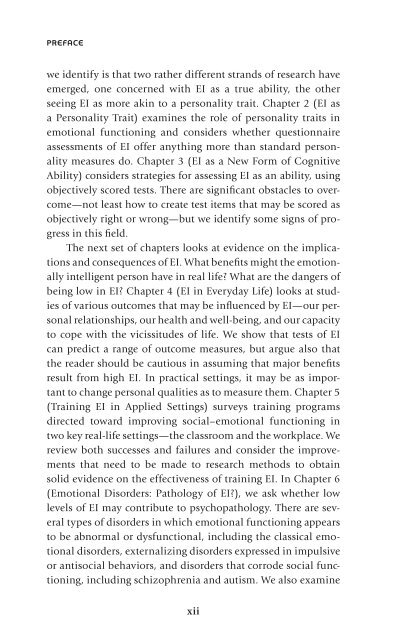Untitled - Springer Publishing
Untitled - Springer Publishing
Untitled - Springer Publishing
Create successful ePaper yourself
Turn your PDF publications into a flip-book with our unique Google optimized e-Paper software.
PREFACE<br />
we identify is that two rather different strands of research have<br />
emerged, one concerned with EI as a true ability, the other<br />
seeing EI as more akin to a personality trait. Chapter 2 (EI as<br />
a Personality Trait) examines the role of personality traits in<br />
emotional functioning and considers whether questionnaire<br />
assessments of EI offer anything more than standard personality<br />
measures do. Chapter 3 (EI as a New Form of Cognitive<br />
Ability) considers strategies for assessing EI as an ability, using<br />
objectively scored tests. There are significant obstacles to overcome—not<br />
least how to create test items that may be scored as<br />
objectively right or wrong—but we identify some signs of progress<br />
in this field.<br />
The next set of chapters looks at evidence on the implications<br />
and consequences of EI. What benefits might the emotionally<br />
intelligent person have in real life? What are the dangers of<br />
being low in EI? Chapter 4 (EI in Everyday Life) looks at studies<br />
of various outcomes that may be influenced by EI—our personal<br />
relationships, our health and well-being, and our capacity<br />
to cope with the vicissitudes of life. We show that tests of EI<br />
can predict a range of outcome measures, but argue also that<br />
the reader should be cautious in assuming that major benefits<br />
result from high EI. In practical settings, it may be as important<br />
to change personal qualities as to measure them. Chapter 5<br />
(Training EI in Applied Settings) surveys training programs<br />
directed toward improving social–emotional functioning in<br />
two key real-life settings—the classroom and the workplace. We<br />
review both successes and failures and consider the improvements<br />
that need to be made to research methods to obtain<br />
solid evidence on the effectiveness of training EI. In Chapter 6<br />
(Emotional Disorders: Pathology of EI?), we ask whether low<br />
levels of EI may contribute to psychopathology. There are several<br />
types of disorders in which emotional functioning appears<br />
to be abnormal or dysfunctional, including the classical emotional<br />
disorders, externalizing disorders expressed in impulsive<br />
or antisocial behaviors, and disorders that corrode social functioning,<br />
including schizophrenia and autism. We also examine<br />
xii<br />
Matthews_PTR_FM_12-10-11_i-xviii.indd xii<br />
10/12/2011 8:48:05 PM
















